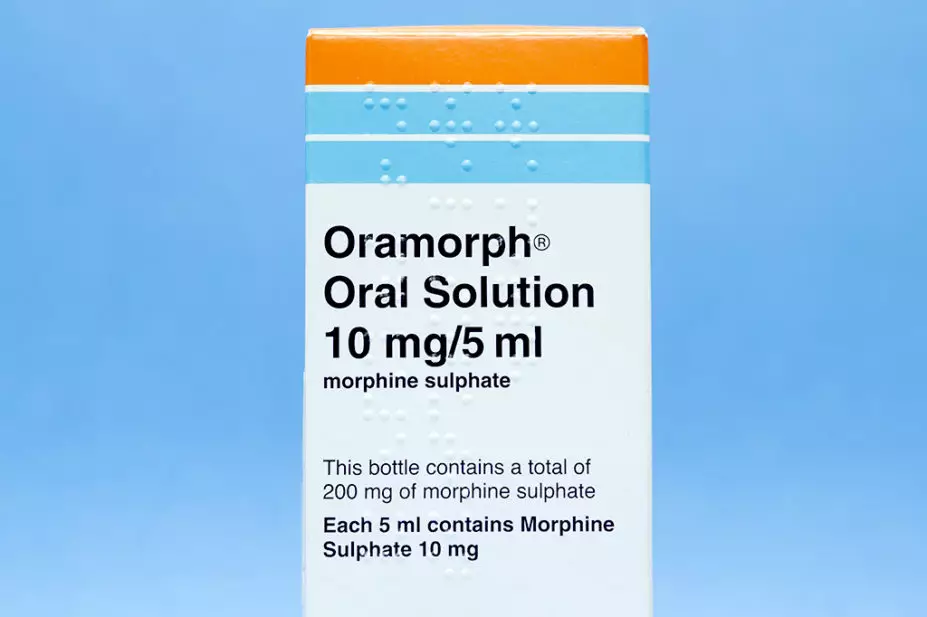
DR P. MARAZZI/SCIENCE PHOTO LIBRARY
The coroner’s reports make for harrowing reading.
The man prescribed Oramorph 0.2% after back surgery, who died from an accidental overdose of oral morphine sulphate solution after being known “to swig out of the bottle”.
The retired nurse who “hoarded” 100mL bottles of Oramorph 0.2% — prescribed to manage pain from rheumatoid arthritis — before taking a “deliberate overdose”.
However, an analysis by The Pharmaceutical Journal of ‘prevention of future deaths’ reports*, published on the Courts and Tribunals Judiciary website since 2013, has revealed that these were not isolated cases.
In fact, our research shows that Oramorph or oral morphine sulphate solution was directly linked to the cause of death in 13 of these reports since 2013.
Of these, concerns were raised by coroners about Oramorph or oral morphine sulphate solution following investigations into the death of five people. An additional concern about the use of Oramorph was raised following one death that was ruled as a result of “natural causes” (see Box 1).
In three reports, coroners were so concerned about the risk of accidental death or abuse with Oramorph or oral morphine sulphate solution that they called for additional restrictions to be put in place for Oramorph 10mg/5mL, and sent their prevention of future deaths reports to the Department of Health and Social Care and other government bodies for consideration.
Most recently, in April 2021, the death of Helen Spicer at Royal Cornwall Hospital in Truro was ruled a “drug related death” owing to an unintentional overdose of Oramorph by a coroner, who pointed out that he was unable to determine who collected the prescription for the drug because there was no requirement for it “to be signed for”.
The prevention of future deaths report was sent to the chair of the Advisory Council on the Misuse of Drugs, expressing concern around “the absence of restrictions on the import, export, possession or administration of oral morphine” and warning of “a risk of abuse” of the drug.
In December 2018, the death of Joan Wright was found to be one of “natural causes”. However, the prevention of future deaths report said the coroner’s inquest had found she was “given Oramorph incorrectly” in the days preceding her death and that it was a matter of concern “that Oramorph has different classifications depending on the strength prescribed”.
In the report, which was sent to the health secretary, the coroner said that opioids “can have a significant impact at whatever strength they are prescribed if given in excess”.
In January 2016, a coroner’s inquest found that Christine Stevenson died of combined drug toxicity, including Oramorph. The subsequent prevention of future deaths report noted that, during the inquest, “it could not be established” who collected the final prescription of Oramorph 0.2% dispensed for Stevenson before she died, owing to the drug’s classification as a schedule 5 controlled drug.
In the report, which was sent to the Medicines and Healthcare products Regulatory Agency, the coroner raised concerns around “the lack of control for Oramorph medication” and suggested that limits be placed on the amount that can be prescribed.
The issue was disregarded by the Home Office at the time, saying in its response to the report in June 2016 that limiting “the amount of Oramorph which can be prescribed … may have unintended consequences and could have a negative impact on some patients’ care”.
Box 1: The victims
Helen Spicer, April 2021
A coroner ruled that Helen Spicer died in October 2018 in Truro, Cornwall, from an unintentional overdose of Oramorph prescribed for fibromyalgia, which was classified under schedule 5 (i.e. 0.2% strength). The coroner was unable to determine who collected the prescription “because there are no requirements in relation to the dispensing of liquid morphine as regards the need for the prescription to be signed for on collection”.
The coroner’s report was sent to the chair of the Advisory Council on the Misuse of Drugs expressing a concern around “the absence of restrictions on the import, export, possession or administration of oral morphine” and warned of “a risk of abuse” of the drug.
George Rimmer, August 2019
A coroner in West Sussex ruled that George Rimmer died from an accidental overdose of Oramorph. Rimmer was prescribed Oramorph 0.2% after back surgery, which he was known “to swig out of the bottle”. The coroner said it was a concern that Rimmer’s “GP did not recall advising him of the possible consequences of exceeding the prescribed dose”.
Joan Wright, December 2018
In December 2018, a coroner in south Manchester ruled that Joan Wright died of natural causes. However, the inquest noted she “had been given Oramorph incorrectly” in the days before her death. The coroner highlighted a concern to the health secretary that “Oramorph has different classifications depending on the strength prescribed”, adding that “opioids can have a significant impact at whatever strength they are prescribed if given in excess”.
Janice Davies, December 2018
A coroner in South Wales ruled that Janice Davies had died, in part, owing to morphine toxicity after being switched from a prescription of 10mL Oramorph four times daily, which Davies could not tolerate, to oxyNorm (Napp Pharmaceuticals Limited) — a brand of oxycodone — after suffering a fall at home. The coroner said he was concerned about an absence of formal guidance for A&E clinicians “regarding the prescribing of Oramorph to discharging patients”.
Christine Stevenson, January 2016
A coroner in south Manchester ruled that Christine Stevenson died of combined drug toxicity from prescribed and illicit drug use, including Oramorph 10mg/5mL, which was prescribed following a leg amputation five months before her death.
The coroner’s ‘prevention of future deaths’ report highlighted concerns to the chief executive of the Medicines and Healthcare products Regulatory Agency about “the lack of control for Oramorph medication”, after the investigation left her unable to determine who collected a prescription of the medicine, which later contributed to Stevenson’s death. The coroner noted that Oramorph has “increasing street value and is a commonly abused drug”. She suggested that “whilst the strength of the solution may not require control, the issuing of 500mls without control seems a matter which requires consideration”.
Bridget Cahill, May 2014
A coroner in Manchester ruled that Bridget Cahill died of a morphine overdose. Cahill, who “had a background of Parkinson’s disease, dementia and chronic backache”, had been prescribed 20mL of Oramorph per day but “at no time prior to her death did she have the maximum permitted dose”. The coroner said it was concerning that a patient “who has less than the amount [of morphine] prescribed for them can nevertheless suffer an overdose”.
Source: Courts and Tribunals Judiciary website
The health service is aware of the problems with lower concentrations of liquid morphine.
In 2016, the NHS South West region issued a warning saying that there had been “a lot of incidents reported across the South West” involving morphine sulfate 10 mg/5mL oral solution, with some patients “swigging” the medicine, rather than measuring out their dose.
It said that while this medicine can be a useful treatment for “breakthrough pain”, particularly in end-of-life patients with swallowing difficulties, long-term use could cause problems. It explained: “A prescription for morphine sulfate 10 mg/5 mL oral solution 5–10ml qds could add up to 80mg morphine daily, compared with tramadol 50mg 2 qds being equivalent to 60mg morphine daily, and co-codamol 30/500mg 2 qds equivalent to 24mg morphine daily.”
The organisation went on to raise the problem of the medicine’s current classification: “Despite a 300ml bottle of morphine sulfate 10 mg/5 mL oral solution containing the same amount of morphine as 60 Zomorph 10mg capsules, it is legally classed as a Schedule 5 rather than as a Schedule 2 CD [controlled drug] and so is effectively treated as a POM [prescription-only medicine].
“This may give prescribers the impression that it is a less dangerous medicine than the morphine solid dose forms, in terms of patient safety and risks of misuse and diversion. However, the following incidents show how much of a risk morphine sulfate oral solution presents.”
It went on to list several examples, such as a woman taking six litres of oral morphine sulphate solution every two weeks and a man storing up enough solution to use it to die by suicide and attempt to kill his wife.
Despite all of these examples, to date, no additional restrictions have been introduced by the Home Office.
Commenting on The Pharmaceutical Journal‘s findings, a spokesperson for the Home Office said: “Any death due to drug misuse is a tragedy. The government’s approach remains clear — we must prevent drug misuse in our communities and support people through treatment and recovery.
“While there are no plans at present to consider the rescheduling of oral morphine, we continue to work closely with the Department of Health and Social Care in understanding the complex factors involved in addition, and protect individuals from these harms.
The spokesperson added that Project ADDER “will combine stepped up enforcement with more rehabilitation for those with addictions in the hardest-hit areas in England and Wales”.
In January 2021, the government invested £28m into piloting Project ADDER, which combines tougher policing with enhanced treatment and recovery services.
But many UK pain experts agree that the time has come for a rethink on Oramorph 0.2%.
Dr John Hughes, dean of the Faculty of Pain Medicine — the professional body responsible for the training and practice of clinicians specialising in pain medicine — said there was a potential risk of overdose with oral morphine, especially if it is taken outside the limits of the prescription.
He added: “The coroner [in the case of Helen Spicer in April 2021] was correct to inform the Advisory Council on the Misuse of Drugs regarding their concerns over the classification of oral morphine 10mg/5mL. Although the concentration of the oral morphine solution is relatively low, the 100mL, 300mL and 500mL prescribable volumes available provide a total dose of 200mg, 600mg and 1,000mg, which allow for a significant risk of harm, misuse or misappropriation.”
Cathy Price and Michael Serpell, trustees at Pain Concern, a charity for patients experiencing pain, added that although 0.2% morphine sounds weak, “if taken in large volumes it carries a potentially very high dose of morphine”.
“It doesn’t make pharmacological sense to categorise it as schedule 5, without stating a limit to the amount or volume of the drug,” they added.
Cathy Stannard, a consultant in complex pain in Gloucestershire and clinical lead for the National Institute for Health and Care Excellence guideline on chronic pain, added that it “makes sense” for Oramorph to be more tightly controlled.
“[Oramorph is] particularly problematic because it’s a liquid and people swig it, so that means there’s a lack of control over dose when people are taking it,” she said. “It’s more of a challenge to measure out the right dose than it is to pop a pill out of a strip.”
In the absence of any imminent action by the government, what can prescribers do?
“One thing where there needs to be a bit of a push is for prescribers to recognise that Oramorph need not be the default immediate release preparation [and] that we could be giving immediate release tablets, so Sevredol.
“When I talk to GPs, they say we can’t use Sevredol because it’s more expensive. It’s not, so dose for dose, it’s the same.
“And, in terms of its pharmacokinetics, although I think a lot of patients feel that a liquid will act more quickly, it doesn’t actually reach peak concentration any quicker than the tablets,” Stannard added.
Emma Davies, advanced pharmacy practitioner in pain management at Cwm Taf Morgannwg University Health Board, says that concerns around how much lower concentration oral morphine sulphate solution is prescribed, and how easily it can be misused, is leading to some treating it as a schedule 2 medicine.
She said: “It must be the most commonly ‘dropped’ medicine in the UK, because the number of patients who drop bottles of Oramorph and need a replacement is significant,” she said, clarifying that this is a potential tactic used by patients “as a way of getting more”.
Davies added that there are some hospitals that already treat Oramorph as a schedule 2 drug and “insist on a double nurse check”.
“I don’t think there would be huge objections to rescheduling it,” she continued, but added that “getting timely administration” in palliative settings in secondary care would be a significant concern if Oramorph was rescheduled.
In the NHS’ warning on morphine sulfate from 2016, there is some good advice. It recommends looking at the amount put on repeat prescription, considering prescribing tablets instead and raising any suspicious prescriptions with the responsible officer (see Box 2).
In the absence of any action from ministers, it seems that healthcare professionals are going to have to take the care of vulnerable patients into their own hands.
*Under paragraph 7 of schedule 5 of the Coroners and Justice Act 2009, coroners have a duty to make reports to a person, organisation, local authority or government department or agency where the coroner believes action should be taken to prevent future deaths. These reports are usually written after the coroner’s inquest into a death is closed.
Box 2: How to keep patients safe
- Morphine sulfate oral solution is a risky analgesic option for patients with a history of mental illness, self-harm or personality disorder. For an opioid naïve patient, 100mL of morphine sulfate 10mg/5mL oral solution (200mg morphine) can be a fatal dose — especially if they are already taking other central nervous system (CNS) depressant medicines, such as diazepam, zopiclone or selective serotonin reuptake inhibitors.
- Placing morphine sulfate oral solution on repeat or prescribing quantities of 300mL can make it easy for patients to escalate their dose. 100mL as an acute script should be enough for occasional use.
- Consider the risks of prescribing opioids as an oral solution — patients are prone to swig out of the bottle and may unintentionally be taking large doses. If opioids are needed for occasional pain, would a small quantity of immediate release morphine tablets for breakthrough/occasional pain be safer?
- Consider the risks of respiratory depression when prescribing analgesia for patients with underlying risk factors, e.g. COPD or heart failure, especially if they are already taking other CNS depressant medicines. For many older patients, the risks of non-steroidal anti-inflammatory drugs for chronic pain will be less than the risks of taking opioids.
- Oramorph is often the target of people seeking prescription medicines for misuse or diversion — if you are suspicious of any prescription requests, please inform your controlled drugs accountable officer.
Source: NHS South West region, controlled drugs newsletter, August 2016


